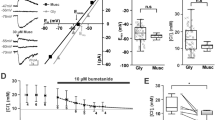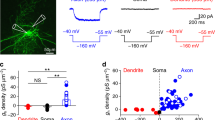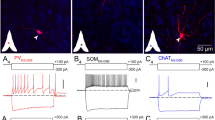Abstract
With the exception of acetylcholine at the motoneurone–Renshaw cell synapse, the excitatory chemical transmitters of the major pathways in the vertebrate brain are unknown1. However, on the basis of biochemical and electrophysiological experiments at the extracellular level, the excitatory acidic amino acids glutamate and aspartate have long been suggested as the most likely candidates for this role2–4. Unfortunately, difficulties with recording intracellularly from postsynaptic cells at many of these synapses and the lack of selective antagonists have curtailed the criteria by which the identification of glutamate and aspartate as transmitters can be explored. We have now made intracellular recordings from granule cells of the dentate gyrus in vitro and report that γ-D-glutamylglycine (γ-DGG) is an effective antagonist of the excitatory postsynaptic potential (e.p.s.p.) evoked by stimulation of the medial perforant path (PP). During this antagonism the reversal level of the e.p.s.p. remains the same and the passive membrane properties of the postsynaptic membrane are unaltered. Quantal analysis shows that the reduction in the e.p.s.p. amplitude can be accounted for almost entirely by a reduction in quantal size while the quantal content remains unchanged, indicating a direct reduction in the postsynaptic sensitivity to the endogenous transmitter. (±)2-Amino-5-phosphonovalerate (APV) proved to be ineffective as a blocker of the PP-evoked e.p.s.p. and cis-2,3-piperidinedicarboxylate(PDA) caused excitation. The selectivity of γ-DGG and APV against the depolarization induced by the iontophoretic application of N-methyl-D-aspartate (NMDA), quisqualate and kainate closely resembled that in spinal cord. This constitutes the first evidence from a readily identifiable synapse in support of the view that excitatory amino acid receptors of the quisqualate/kainate type are involved in synaptic transmission and offers further support for the suggestion that the endogenous transmitter is aspartate or glutamate.
This is a preview of subscription content, access via your institution
Access options
Subscribe to this journal
Receive 51 print issues and online access
$199.00 per year
only $3.90 per issue
Buy this article
- Purchase on Springer Link
- Instant access to full article PDF
Prices may be subject to local taxes which are calculated during checkout
Similar content being viewed by others
References
Eccles, J. C. The Physiology of Synapses (Springer, Berlin, 1964).
Johnson, J. L. Prog. Neurobiol. 10, 155–202 (1978).
Curtis, D. R. in Glutamic Acid: Advances in Biochemistry and Physiology (eds Filer, L. J., Garattini, S., Kare, M. R. & Reynolds, W. A.) 163–175 (Raven, New York, 1979).
Krnjevic, K. & Phillis, J. W. J. Physiol., Lond. 165, 274–304 (1963).
Watkins, J. C. & Evans, R. H. A. Rev. Pharmac. Tox. 21, 165–204 (1981).
Davies, J. & Watkins, J. C. Brain Res. 235, 378–386 (1982).
Davies, J. & Watkins, J. C. Brain Res. 206, 172–177 (1981).
Davies, J., Evans, R. H., Francis, A. A., Jones, A. W. & Watkins, J. C. J. Neurochem. 36, 1305–1307 (1981).
McNaughton, B. L. & Barnes, C. A. J. comp. Neurol. 175, 439–454 (1977).
Spencer, H. J., Gribkoff, V. K., Cotman, C. W. & Lynch, G. Brain Res. 105, 471–481 (1976).
Wheal, H. W. & Miller, J. J. Brain Res. 182, 145–155 (1980).
Nadler, J. V., White, W. F., Vaca, K. W., Redburn, D. A. & Cotman, C. W. J. Neurochem. 29, 279–290 (1977).
Sandoval, M. E., Horch, P. & Cotman, C. W. Brain Res. 142, 285–299 (1978).
Andersen, P., Holmqvist, B. & Voorhoeve, P. E. Acta physiol. scand. 66, 448–460 (1966).
Lomo, T. in Excitatory Synaptic Mechanisms (eds Andersen, P. & Jansen, J. K. S.) 207–211 (Universitetforlaget, Oslo, 1970).
Ginsborg, B. L. Pharmac. Rev. 19, 289–316 (1967).
Hubbard, J. I., Llinas, R. & Quastel, D. M. S. Electrophysiological Analysis of Synaptic Transmission (Arnold, London, 1969).
Kuno, M. Physiol. Rev. 51, 647–678 (1971).
McNaughton, B. L., Barnes, C. A. & Andersen, P. J. Neurophysiology, 46, 952–966 (1981).
Katz, B. Nerve, Muscle and Synapse (McGraw Hill, New York, 1966).
Author information
Authors and Affiliations
Rights and permissions
About this article
Cite this article
Crunelli, V., Forda, S., Collingridge, G. et al. Intracellular recorded synaptic antagonism in the rat dentate gyrus. Nature 300, 450–452 (1982). https://doi.org/10.1038/300450a0
Received:
Accepted:
Issue Date:
DOI: https://doi.org/10.1038/300450a0
This article is cited by
-
Effect of age on ?-amino-3-hydroxy-5-methylisoxazole-4-propionic acid (AMPA) binding sites in the rat brain studied by in vitro autoradiography
Neurochemical Research (1991)
-
Glutamate in the mammalian CNS
European Archives of Psychiatry and Clinical Neuroscience (1990)
-
Frequency-dependent involvement of NMDA receptors in the hippocampus: a novel synaptic mechanism
Nature (1986)
Comments
By submitting a comment you agree to abide by our Terms and Community Guidelines. If you find something abusive or that does not comply with our terms or guidelines please flag it as inappropriate.



